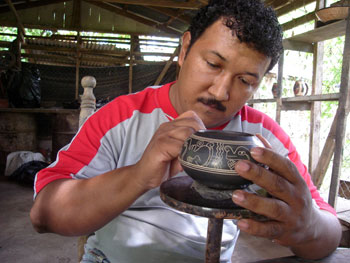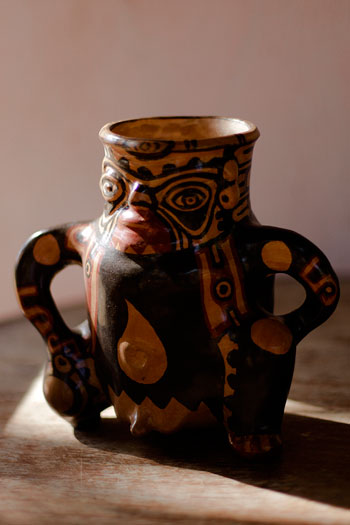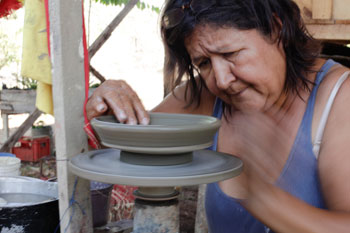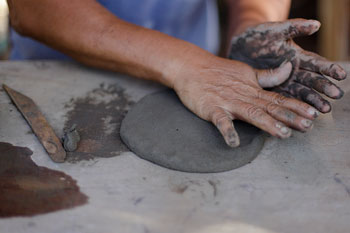A few days from the start of winter, the hands of the artisans of San Vicente of Nicoya are idle due to the lack of clay and their families are distressed from not having resources.
"I've dedicated 35 years to this job and we have never lacked clay. Those who have a little bit stored are singing glory, but those of us who don't have any more are wiped out," said Gabriel Chavarría anxiously in his small ceramic shop.
Carlos Grijalba |
|
 |
For 4,000 years, using and producing ceramics have been associated with Guanacastecans in one way or another. The practice appeared some 2,000 years before Christ with the indigenous people called the Chorotegas, and its use and significance during the pre-Columbian era were domestic, symbolic and ritualistic.
Buying property
The only option that could help these inhabitants, totally dependent on this material from mother nature, get ahead is to buy a property owned by a family by the last name of Solórzano, which possesses sixteen hectares in San Vicente with an important deposit of clay.
However, the large impediment is that, though the owners have agreed to sell the estate, the price of 830 million colones (more than $1,660,000) is out of reach for the local potters.
Regardless, according to the potters, even though both the Municipality of Nicoya and the government have offered help with the purchase of this property, the promises have gotten tangled up in bureaucratic red tape and in the meantime, they have no idea how to get by short term.
A geologist from the Ministry of Environment, Energy and Telecommunications (MINAET) recently concluded studies on this finca; but aside from this nothing has been resolved.
A ceramic vase with a warrior figure. Chorotegas were known to be polytheists. Their belief system has reflected on the designs of their craft. |
|
 |
The objective of the study, requested by the administrations of former presidents Abel Pacheco (2002-2006) and Oscar Arias (2006-2010), concluded at the end of last year, was to learn if the land really is optimal for the extraction of material for making ceramics. To date, the artisans don't know the results of the report prepared by the professional from MINAET.
For villagers from these towns, it's not a matter of just abandoning an artisan practice, but rather an ingrained tradition that has contributed greatly to the culture, outside and inside the country. The problem first manifested itself since 13 years ago has reached its climax. The clay was exhausted.
"The money we make doesn't stretch to buy basic foods, much less for school tuitions and the purchase of materials requested of our children in the elementary and high schools," indicated Elena Rodriguez, from the San Vicente Artisans Association.
For now, with the little they can make, their products are marketed in their homes, in the ceramics eco-museum in this very community and in hotels on the Santa Cruz coast.
Working with the leftovers
Since the last loads of clay that they managed to extract from a municipal property in this same community aren't pure, the pieces they mold break easily when submitted to the firing process, so all the work is in vain.
"The majority of us work with material that is leftover from another artisan… we're like a seamstress making suits from odds and ends," pointed out Bernardo Vega, president of the association. |
|
 |
Yolanda Alcocer, one of the few fortunate enough to still have clay in her shed, doesn't stop thinking about the moment when it will run out. "My daughters and I all our lives have subsisted thanks to this. We don't know what to work in when the little material we have runs out. What will we live on, what?" she asked anxiously.
Up until now, the clay for producing the artwork was pulled out of natural deposits extracted from lands donated by the Municipality. From there, two types of clay were obtained: bay clay—of a softer consistency—and black clay, which is finer and was used historically for preparing pots and comals (flat earthenware dishes).
"Now for sure there isn't any," Maribel Sanchez, Director of the San Vicente museum, commented with concern. "They have gone to the government for help; also they asked owners of the finca to sell us a few hectares but the price is too high, on top of which, of the 16 hectares they have for sale, only two have the necessary material."
The inhabitants of San Vicente haven't sat back waiting for help. They have looked for alternatives such as working with other materials, although the change would mean a variation in the pigmentation of the pieces. Sanchez says, "What we use here is a special earth; it's a mine. We've tried with other clays but they don't work: they can be formed and fired but not painted," she concluded.
Maribel Sanchez Grijalba has been making ceramics with the same technique since she was 10 |
|
 |
Aside from this, the National University has sent a report to the minister of social wellbeing, Fernando Marin Rojas, about the social state in which the inhabitants live, to present the worrisome threat of losing the millenniums-old tradition that has provided a living for the artisans of San Vicente.
 |
| |
More Regional News
Tsunami Alarm Tested!
On Thursday, on May 26th, 2011 at noon, the Tsunami Alarm, located in Lot 111 of Section A, below Villa Mango, was tested with the purpose of finding out the aerial coverage of the alarm system. It was only heard at Pelada Beach.
Tourist Found Dead at Pelada Beach
On Sunday, May 22nd, 2011, Donald Bruce Altieri, 54, was found dead on his bed at Condominios Las Palmas of Pelada Beach. Altieri, from the United States was on vacation with his son, Daniel Bruce Altieri.
Closure of the Nosara Dump
Ministry of Heath Agrees on Two More Months for the Operation of Nosara Dump
Municipality and the Community Leaders of Nosara united to accomplish orders of the Ministry of Health
“I promise not to close the dump as long as there are efforts to improve it,” said Gabriel Sotelo González, inspector from the Nicoya Ministry of Health during a meeting on May 18th at Hotel L’acqua Viva.
Search Ends, Lost Surfer Not Found
“You don´t know how strong you are, until being strong is the only choice you have,” said Margarita Durán, Alvaro Durán’s sister, on a Facebook status post on May 3, 2011.
Closure of Nosara Dump
Community Leaders Call for Municipal Equipment to Avoid Closure
Nosara's community leaders joined together to present a letter to the City of Nicoya asking that the municipality "bring in the equipment to make new trenches" in the dump in Nosara, which is subject to a March 22 closure order issued by the Ministry of Health.
Mel Gibson's Property Still Facing Trouble with Nicoya's Town Council
Rumors in the area indicate the estate would be bought by Lady Gaga
Problems continue to plague Mel Gibson's property on Playa Barrigona, in the Costa Rican province of Guanacaste. In a report issued March 29th, Nicoya's Municipalidad (town council), where the property is located, has stated that the five buildings constructed over 10 years ago never acquired the proper municipal permits.
Ministry of Health Order Closing the Dump Could Bring Local Groups Together
Finding Solutions, Immediate and Long-term, is the Community's Challenge
Trash is not something pleasant to see, to smell or to talk about. Yet, it is certainly a reality of life. As human beings, the only creatures on earth to create inorganic trash, dealing with garbage is an inevitable reality for us. By May 10th, Nosara, a paradise to the visitors, will lose its only dump because of a decision taken by the Ministry of Health. According to the notification sent to the Nicoya municipality, the Nosara's dump "puts the public health at risk."
Attention Guiones and Pelada: Tsunami Alarm Will Be Tested in May
The Tsunami Alarm located in Lot 111 of Section A below Villa Mango, will be tested on May 26th, 2011 at noon. There are five sirens for different purposes: general, radioactivity, chemical, water and fire alarms. They will be tested in the same order they are listed.
Conflict Over Municipal Council Members' Stipends
The Stipend is a compensation that is the right of a functionary, in this case of Municipal Council members. According to the Municipal Code a Council member is entitled to a stipend for attending a paid session of the Council of which he or she is a member. |
 |
|
|

